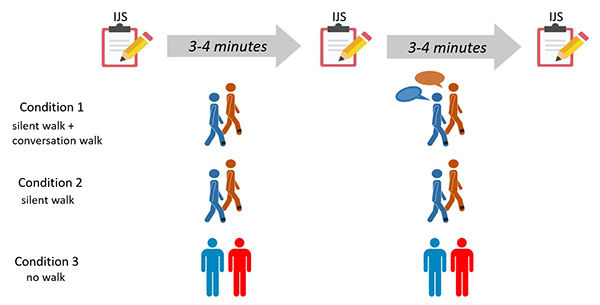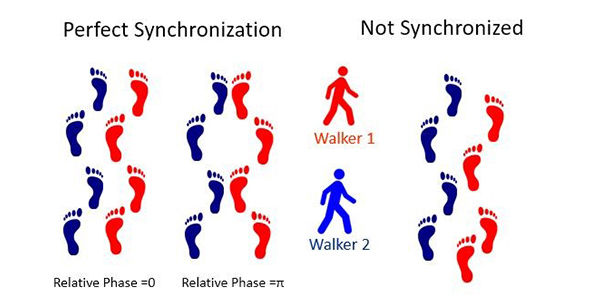First Impressions
Wondering If You Made a Good First Impression? Walk Together
Paired walkers with good first impressions tend to synchronize their footsteps.
Posted February 22, 2020 Reviewed by Davia Sills
Are you someone who uses dating apps? If so, the next time you meet a stranger for a blind date, instead of immediately sitting down, new research suggests that going for a brief walk together may reveal unconscious clues about first impressions. Walking together for a few minutes may also increase your odds of hitting it off when you do actually sit down for a coffee, glass of wine, or have a meal together.

This study (Cheng et al., 2020) suggests that walking for under 10 minutes side by side with someone you've never met helps people "warm up" to one another—regardless of whether the pair walks in silence or converses while walking. These findings were published on February 21 in the journal PLOS ONE.
Even when no conversation was taking place, the researchers from Tohoku University in Japan found that paired strangers with a favorable first impression of one another are more likely to synchronize their footsteps.
"Our analysis revealed a unidirectional relationship between synchrony and impression rating: a better first impression led to higher walking synchrony between two strangers walking side by side in silence," the authors write.
"There is a growing awareness of the validity of interpersonal interaction research in real-world scenarios, but daily natural environments are rich in their contextual information, making experiment control a challenge," first author Miao Cheng said in a news release. "Our study is important because it is an approach to make the most use of an ecological paradigm while using scientific experimental method to control possible confounding variables to examine the function of implicit body synchrony."
For this study, participants who had never met before were paired together and instructed to walk side by side along a quiet path. While walking, a motion sensor disguised as a GPS device was tracking the synchrony of each pairs' footsteps.
The researchers also duped participants into thinking the study had nothing to do with how first impressions affect nonverbal communication (i.e., synchronous walking) so that participants wouldn't be conscious of whether or not they were synchronizing their steps.
The distance of the out-and-back walk was roughly 350 meters (just under a quarter-mile); it took about six-to-nine minutes to complete the round trip at a casual walking pace.
This paired walking experiment was conducted under three different conditions: 1) walking out to the turnaround point in silence, but conversing on the way back; 2) a silent walking condition in which participants were instructed not to speak for the entirety of their out-and-back walk; 3) a non-walking environment where participants sat quietly in a classroom with other study participants and filled out a questionnaire.
At the halfway turnaround point during each side by side walking experiment, paired walkers were asked to rate first impressions of their walking partner using the interpersonal judgment scale (IJS). This scale was also used to rate first impressions after the walk was completed.
In general, people tended to have a better first impression of someone after walking together, regardless of whether or not they conversed. "This suggests that walking side by side, even without verbal communication, is sufficient to alter the social relation between two strangers," the authors said.

The researchers found that having a dialogue while walking side by side enhanced positive first impressions. And, as mentioned, paired walkers with better first impressions of one another at the outset of the experiment had a higher rate of footstep synchronization from the get-go.
"It is very surprising for us to discover that a person's traits and our first impressions are reflected in the subtle action of walking. I think most people are not even aware that their steps are synchronized with other people as they walk," senior author Chia-huei Tseng said in a news release. "It was previously known that a person's physical parameters such as height and weight affect how their movements interact with others. Now we know psychological traits also have an effect."
References
Miao Cheng, Masaharu Kato, Jeffrey Allen Saunders, Chia-huei Tseng. "Paired Walkers With Better First Impression Synchronize Better." PLOS ONE (First published: February 21, 2020) DOI: 10.1371/journal.pone.0227880


